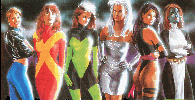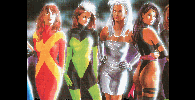I was chatting with a friend of mine about movies the other day, specifically about formats: “letterbox” vs. “pan & scan”. It reminded me of something I posted waaay back on the subject, when TheMook.Net still smelled like a new baby, so I dug it up. It was originally posted on May 21, 1999, on my “Soapbox” page:
————————————————————————————-
“Okay, I know that this rant isn’t exactly a burning world issue, or a hot topic of today’s society…but hell, it’s important to me and this is my soapbox…
Lately I’ve been absolutely swamped with people decrying me as some sort of movie heretic, for the unpardonable crime of…preferring to watch videotapes that are in Letterbox format over the usual “pan & scan” crap.
Now, I’m not trying to pick on people who legitimately prefer to watch “pan & scan” videos, who don’t mind missing out on parts of the scene that the director obviously thought important enough to film. No, this rant is for those people who just don’t have a clue, who in their naivete sincerely believe that they are missing parts of the film if they watch it in Letterbox! After all, there are “big black lines” across the top and the bottom of the screen, so I must be missing parts, right?
WRONG.
If you understand the difference between Letterbox and “pan & scan” there’s really no need to read further. Thanks for checking in, and I hope you had fun. But if you’re not sure, please, I beg you, not just for my sake but for all those who prefer Letterbox, read further and at least understand what the hell it is you’re talking about.
In extremely simple terms, television screens and movie theater screens have different shapes…a TV screen is closer to a square, while a theater screen is a large rectangle. This means that if you are filming a movie, all the scenes appear as rectangles; if you are filming a TV show, all the scenes appear as squares (I told you I was using extremely simple terms). The problem arises when you try to show a rectangular movie scene on a square TV screen…everything just won’t fit. So, the common thing to do is what’s called “pan & scan”, where someone sits down with a copy of the movie, chooses those parts from the rectangular scenes that will fit on a square screen, and shows that on television…in essence, “cutting off the sides” of each and every scene in the entire film.
Now, this won’t make a difference in every single scene…if the scene is a sailboat crossing a lake all you’ll probably miss from “cutting off the sides” is more water. However, if the scene is, say, a group of female members from the X-Men, which takes up the entire rectangular theater screen, then you’ll have a problem. The scene would look like this if you saw it in a movie theater:

But it would only look like this if you watched it on television:

You’d be missing Dazzler and Mystique, the two women on the ends! Unacceptable, I say! I want to see everything, just the way the movie was originally intended to be seen. What Letterboxing does, by adding black borders at the top and bottom of your television screen, is make your square TV screen a slightly smaller rectangular screen so that the entire scene can be shown, without cutting anything off.
Is it annoying? Perhaps, just a tad. But for myself, after watching the movie for five minutes I don’t even notice it anymore, and the positive far outweighs the negative. Watch the climactic space battle at the end of “Return of the Jedi” in both Letterbox and “pan & scan” and tell me which one you prefer…
So there, World. You’ve been fairly warned, and had everything explained to you. I now feel totally justified in smacking the
next person who says to me, “Ewwww, you like Letterbox? God, I hate those lines!””
————————————————————————————-
While Googling around the net after I posted this today, I found a decent flash movie from “www.widescreen.org” that shows the same thing, though a bit better (sorry, my flash movie making skills are non-existent).
Comments
Leave a comment Trackback